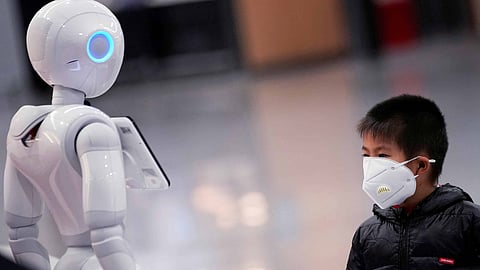

The epic coronavirus that initially showed up in mainland China has now spread over the world, with more than 82,000 reported cases and almost 3,000 deaths, as of last week. What's more, right alongside the outbreak is the deployment of myriad types of AI-powered tech that is now being put on full display.
New innovation like infrared thermometers, possibly unreliable devices known as "thermometer guns" are getting progressively typical in China, where health laborers normally check individuals' temperatures. To some degree in the background, in any case, increasingly modern technology fueled by artificial intelligence is assisting with distinguishing coronavirus symptoms, finding new treatments, and track the spread of the disease. In the meantime, robots are making collaborations with and treatment of debilitated patients simpler. Powerful surveillance tech, including facial recognition empowered cameras and drones, is additionally helping discover individuals who may be wiped out or who aren't wearing masks.
In an offer to limit individual-to-individual contact, artificial intelligence-powered devices equipped with thermometers and cameras are taking patients' vitals and helping doctors determine individuals to have the sickness from a sheltered distance. Others are being utilized to sanitize clinic rooms and even planes.
One such machine is the Temi robot. Created by an Israeli organization, Temi is three feet tall and highlights a touchscreen, Amazon's Alexa innovation, a built-in sound system, a plate for charging telephones and an autonomous navigation system that permits it to move around all alone while staying away from obstructions.
Coronavirus is infectious and difficult to contain, which implies that it's more secure for some human-to-human interactions to be done remotely. Both in hospitals and out in the public, remote correspondence implies that patients abstain from transmitting the illness and health laborers spare time on basic assignments.
Close to Seattle, for example, a robot helped doctors treat an American man diagnosed with the novel coronavirus. The robot, which carried a stethoscope, helped the patient speak with medical staff while constraining their own exposure to the disease. Self-driving vehicles are in any event, delivering supplies to medical workers in Wuhan. As CNN noticed, the Chinese e-commerce company JD.com has been moving packages short distances to a hospital.
Flying robots, otherwise called drones, are additionally in the blend. Shenzhen MicroMultiCopter said in an announcement not long ago that it is deploying drones to patrol public places, spray disinfectant, and conduct thermal imaging. Chinese authorities have utilized drones to follow whether individuals are going outside without wearing face masks or damaging other quarantine rules.
Charged as the world's first affordable personal robot (it costs $1,999), Temi is as of now operational in various divisions, among them healthcare, hospitality, enterprises, retail and education. It was as of late recorded in TIME Magazine's 100 Best Inventions of 2019.
Robotemi which is currently headquartered in Shenzhen, China chose to add uncommon accessories to the machine, including a thermometer to check individuals' temperature and a plate to tray to carry food and drink to patients under quarantine. Temi likewise permits patients to speak with friends and family. Temi is already deployed in a couple of medical clinics in Hong Kong, South Korea and China. It permits doctors to visit these patients without being in contact with them.
Up until this point, many Temi robots have been drafted for work in hospitals, air terminals and elderly-care homes. The machine is likewise being put to use in workplaces all through China to check arriving employees for fever, one of the most unmistakable manifestations of COVID-19. If a medical problem is distinguished, Temi guides the worker to a doctor's office to abstain from contaminating colleagues.
The coronavirus scourge has likewise inspired facial recognition companies to coordinate their tech with thermal imaging. This kind of checking is being utilized to detect whether individuals may have raised temperatures, which may demonstrate whether they've been tainted with the coronavirus and help confirm their personality. SenseTime is selling thermal imaging-empowered facial recognition, as is Sunell, another China-based video surveillance organization, as indicated by an official statement.
In the meantime, in Thailand, a biometric border screening system is currently utilizing fever-recognizing cameras, as per the organization giving that innovation, Germany-based Dermalog.
Regardless of whether deployed in hospital rooms, office buildings or airplanes, industry leaders accept the healthcare industry will come to depend increasingly more on robots in the coming years. Effectively utilized for aiding medical procedures and apportioning meds, autonomous machines are required to make life simpler for medical staff by giving data and different services to patients in a timely manner.
From multiple points of view, these fresher, further developed innovations stand to help battle the coronavirus episode. But on the other hand, there's something tragic about an outbreak being utilized as a support for more surveillance.
Advocates of surveillance tech focus around dangers to people's safety and property, highlighting "perilous" individuals like terrorists and sex offenders. Less frequently, however, do defenders of this innovation point to the dangers related to a potential pandemic. However, presently pundits of surveillance tech, who have commonly contended that the innovation compromises our civil liberties and sometimes doesn't even work will probably need to push against an alternate contention: extreme dangers to public health. It's at last misty how the public will respond to the shifting role of surveillance.
Join our WhatsApp Channel to get the latest news, exclusives and videos on WhatsApp
_____________
Disclaimer: Analytics Insight does not provide financial advice or guidance. Also note that the cryptocurrencies mentioned/listed on the website could potentially be scams, i.e. designed to induce you to invest financial resources that may be lost forever and not be recoverable once investments are made. You are responsible for conducting your own research (DYOR) before making any investments. Read more here.
